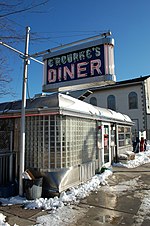Middletown–Portland railroad bridge
Bridges in Middlesex County, ConnecticutBridges over the Connecticut RiverBuildings and structures in Middletown, ConnecticutConnecticut building and structure stubsConnecticut transportation stubs ... and 8 more
Metal bridges in the United StatesNortheastern United States bridge (structure) stubsPortland, ConnecticutProvidence and Worcester RailroadRailroad bridges in ConnecticutSwing bridges in the United StatesTruss bridges in the United StatesUnited States railway bridge stubs
The Middletown–Portland railroad bridge is a swing truss railroad bridge crossing the Connecticut River and Route 9 in Middletown, Connecticut, just south of the Arrigoni Bridge. The bridge is a Warren through-truss swing bridge with an overall length of 1,142 ft (348 m) and a rotating center span. It is used by the Providence and Worcester Railroad to serve freight customers in Portland.The first rail bridge at the site was constructed by the Boston and New York Air-Line Railroad in 1873. It was replaced by the current bridge in 1911. The bridge was featured prominently in the video for the 1993 Billy Joel hit "The River of Dreams".
Excerpt from the Wikipedia article Middletown–Portland railroad bridge (License: CC BY-SA 3.0, Authors).Middletown–Portland railroad bridge
Chester Bowles Highway, Middletown
Geographical coordinates (GPS) Address Nearby Places Show on map
Geographical coordinates (GPS)
| Latitude | Longitude |
|---|---|
| N 41.566666666667 ° | E -72.647777777778 ° |
Address
Chester Bowles Highway
06459 Middletown
Connecticut, United States
Open on Google Maps









